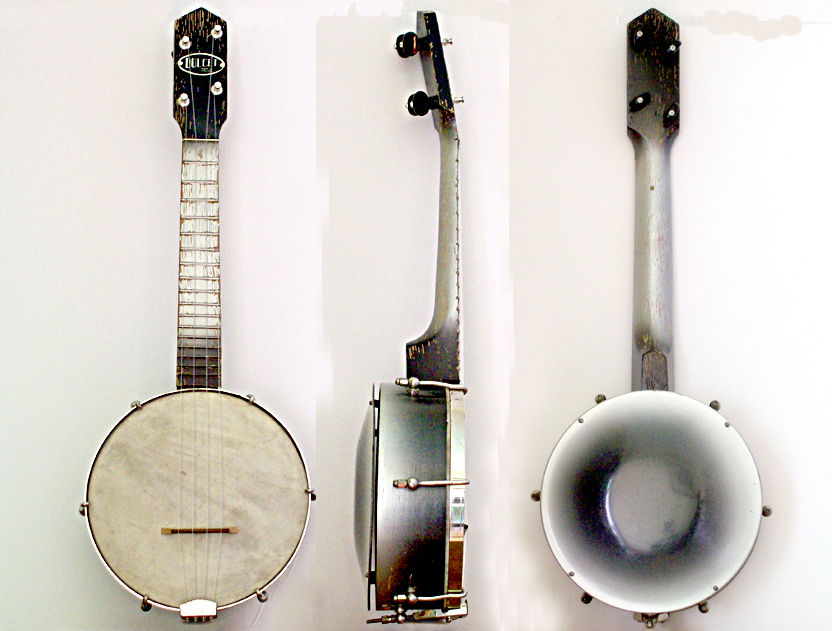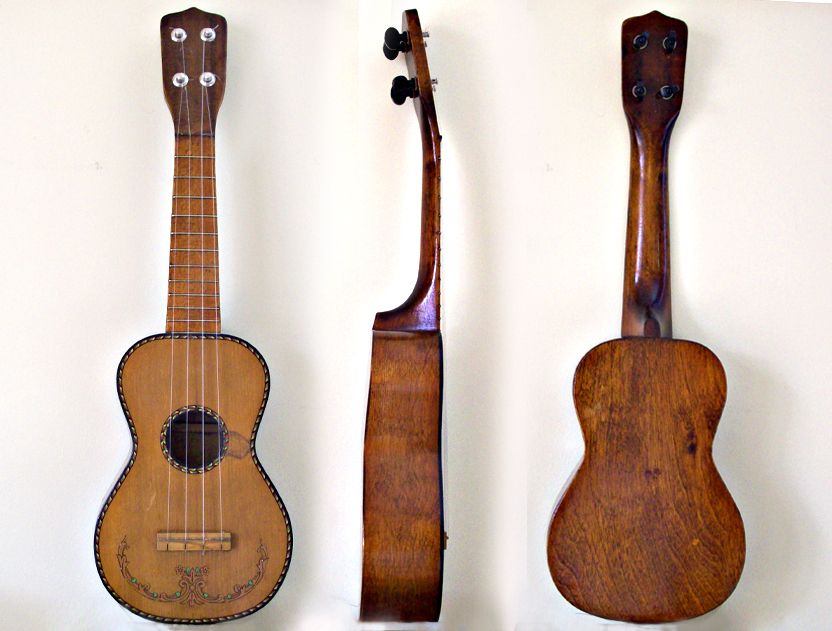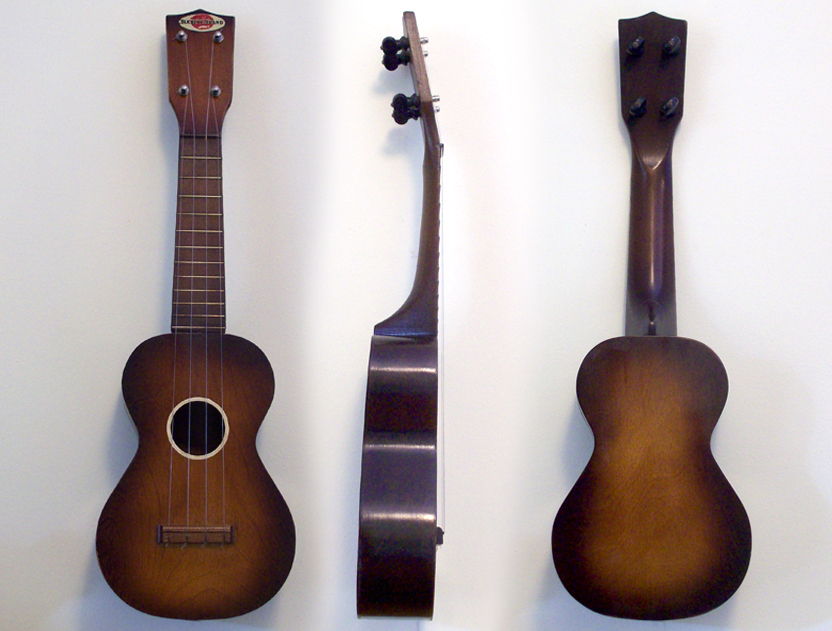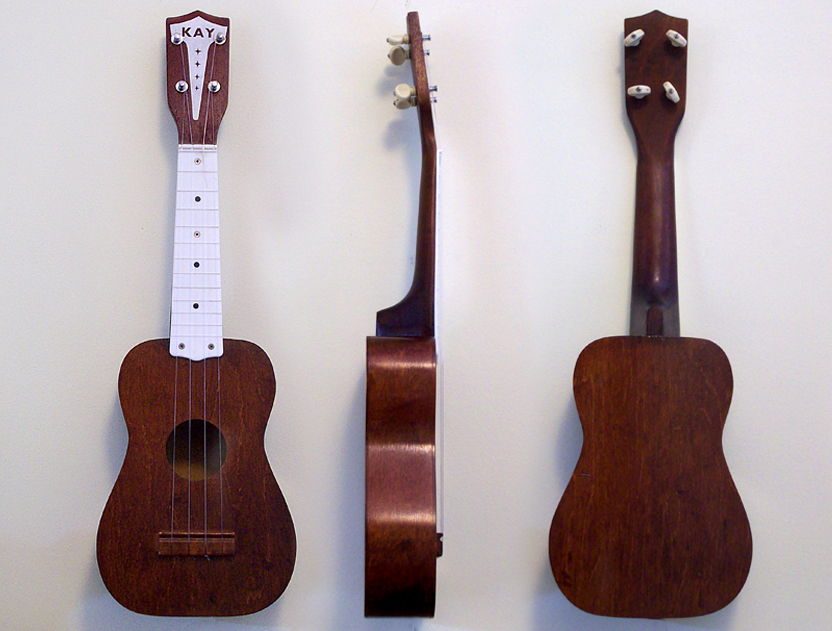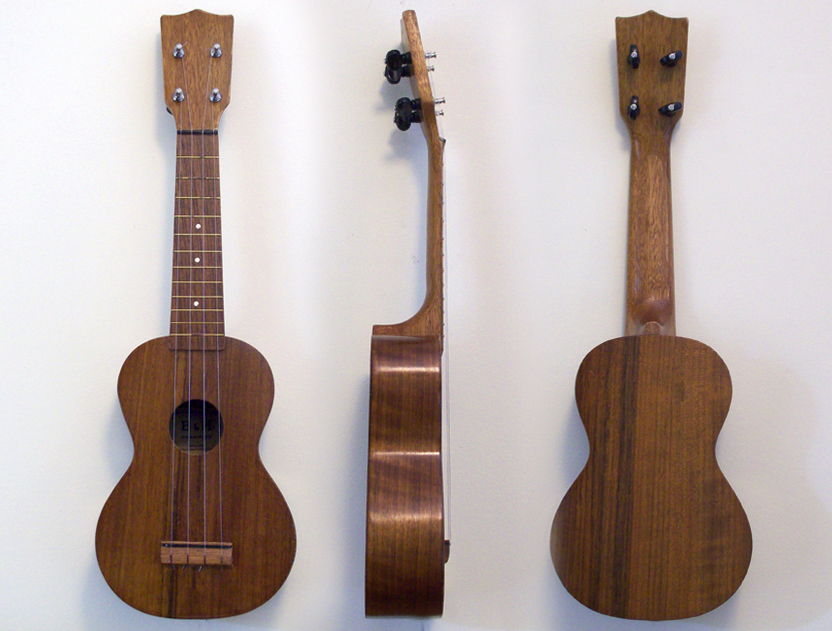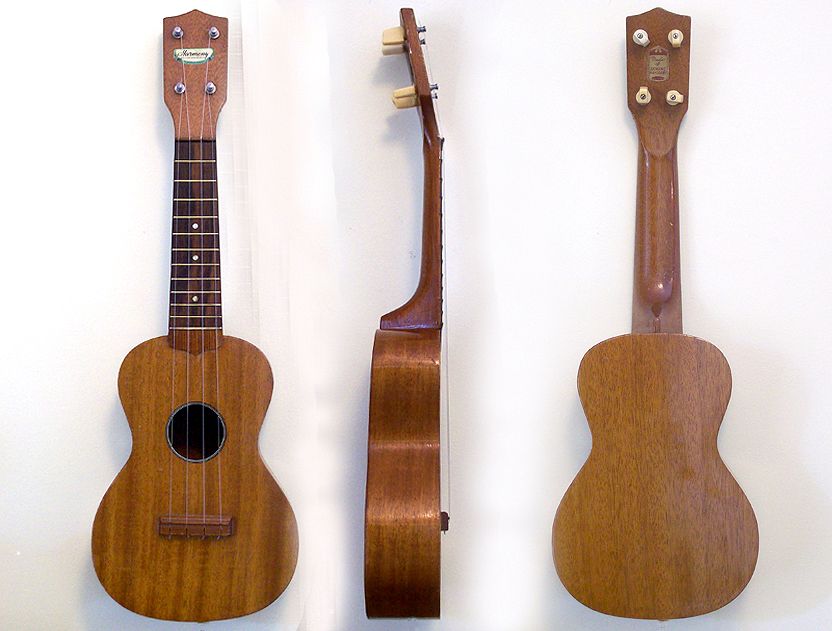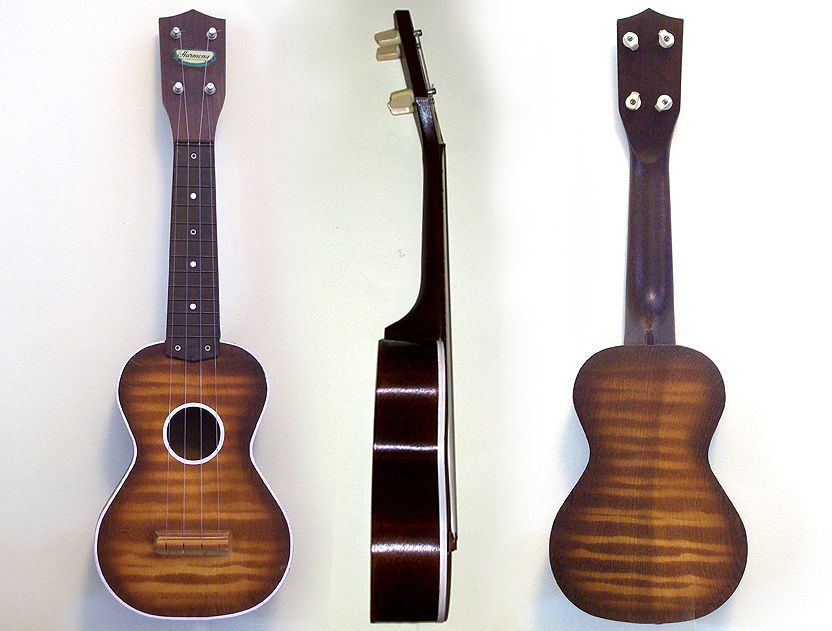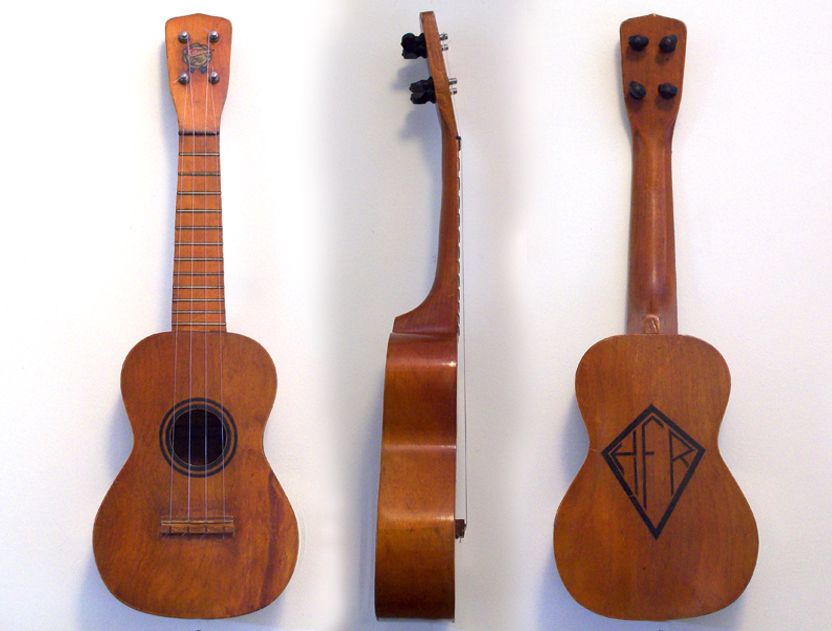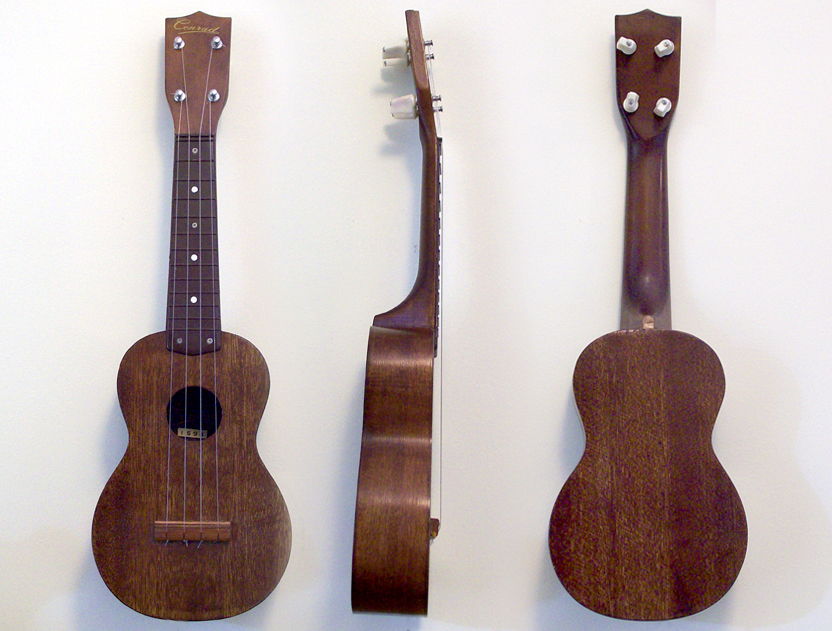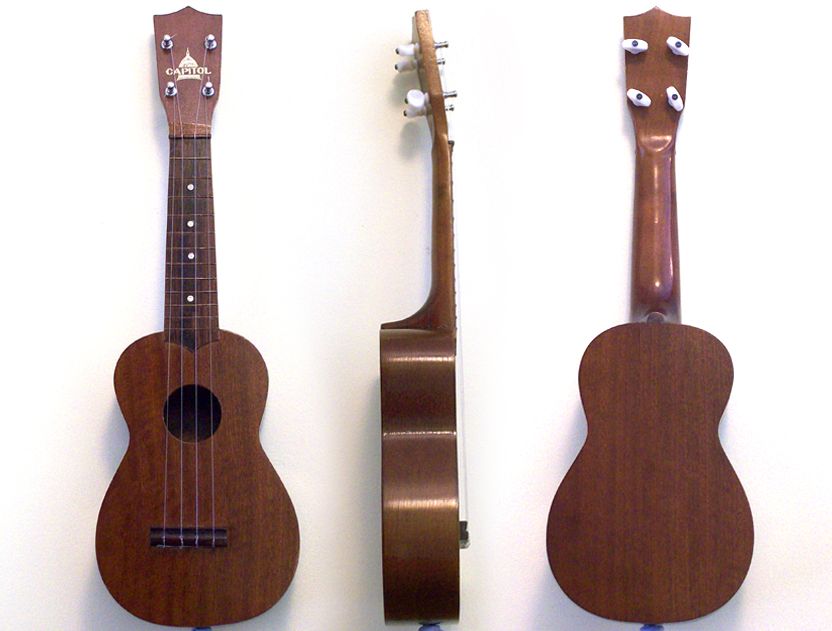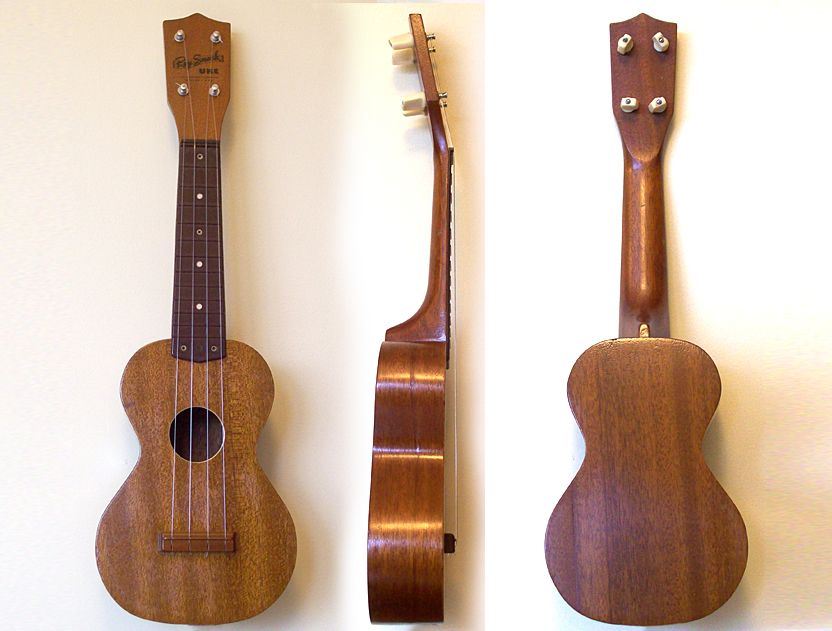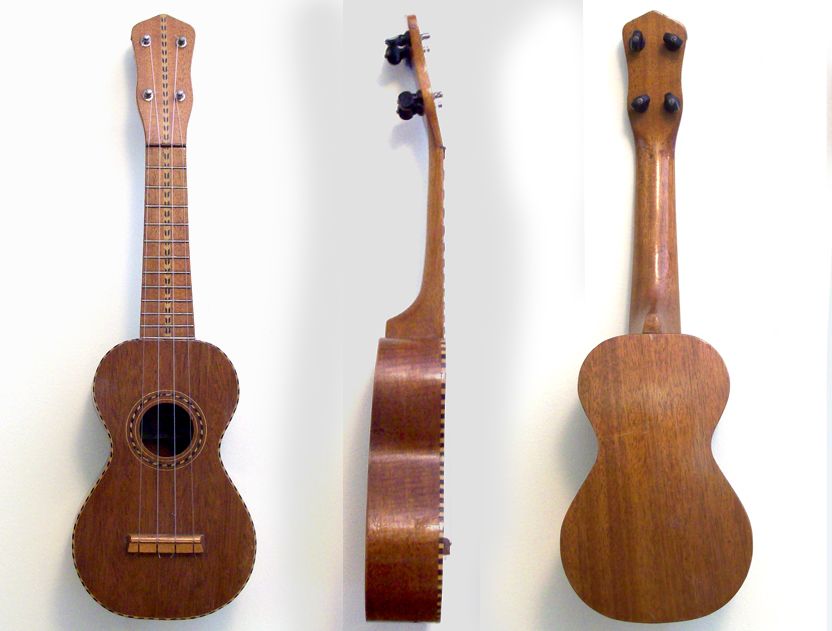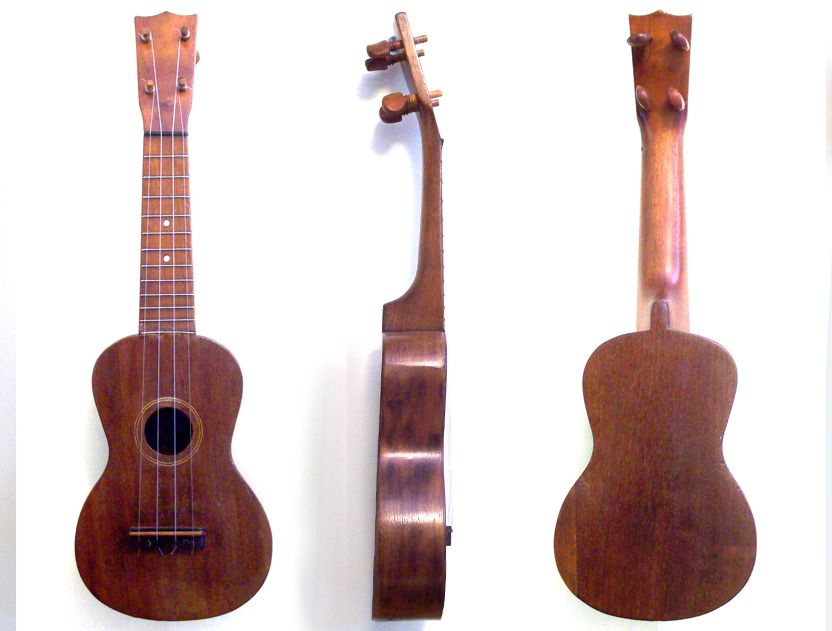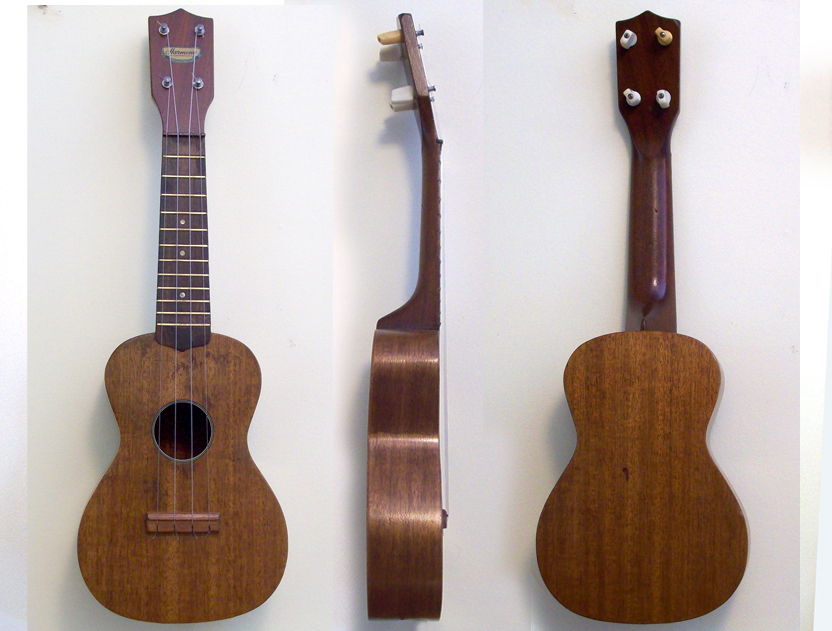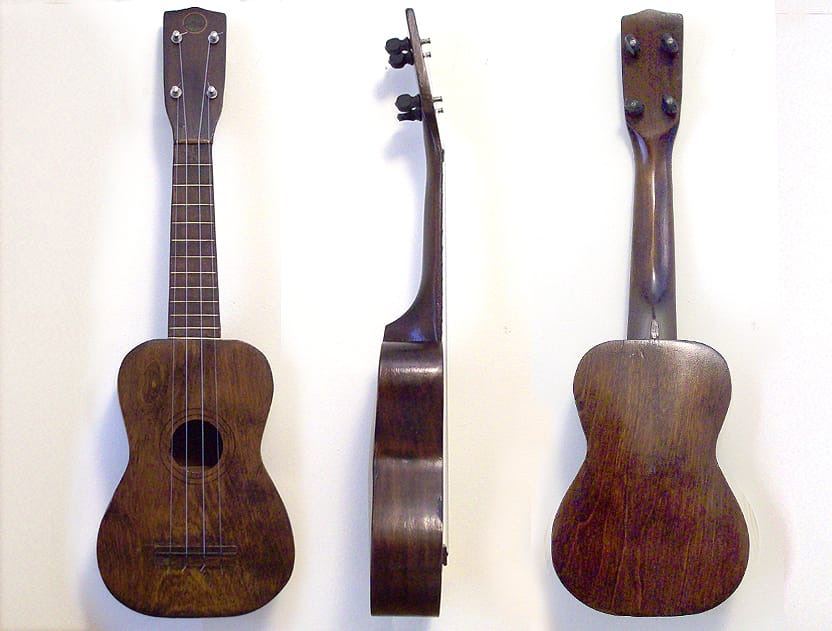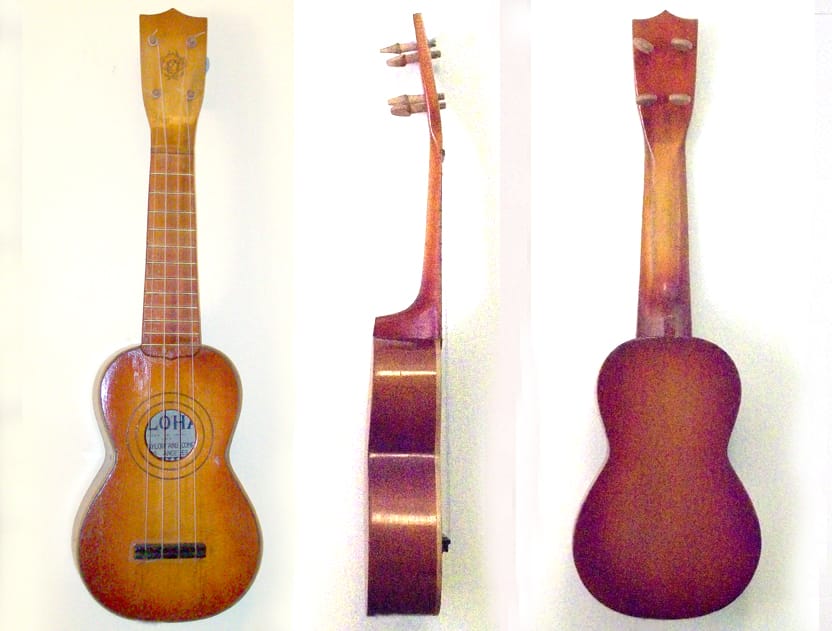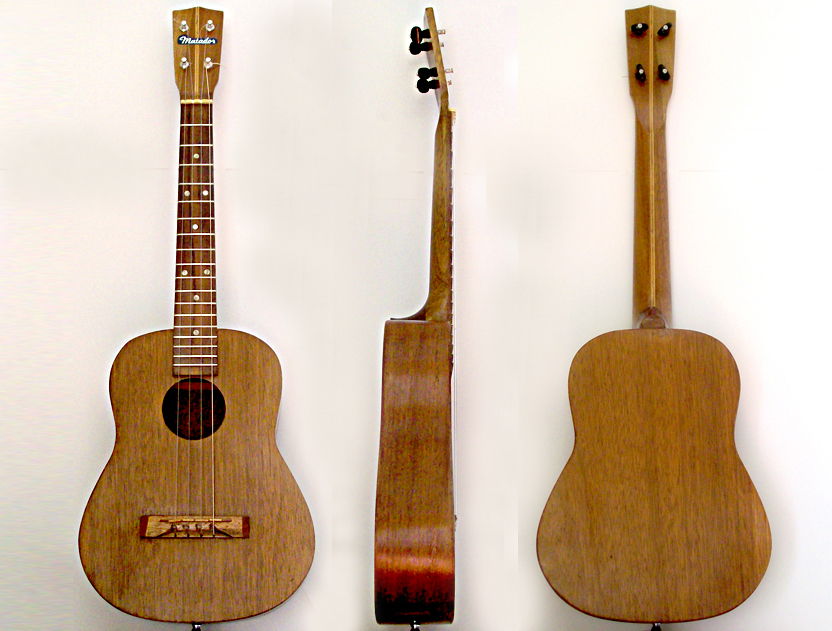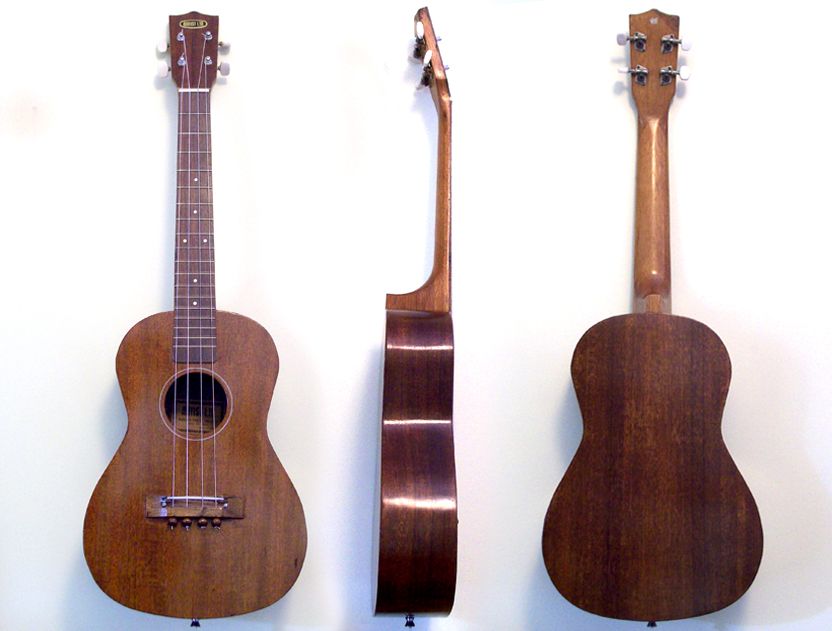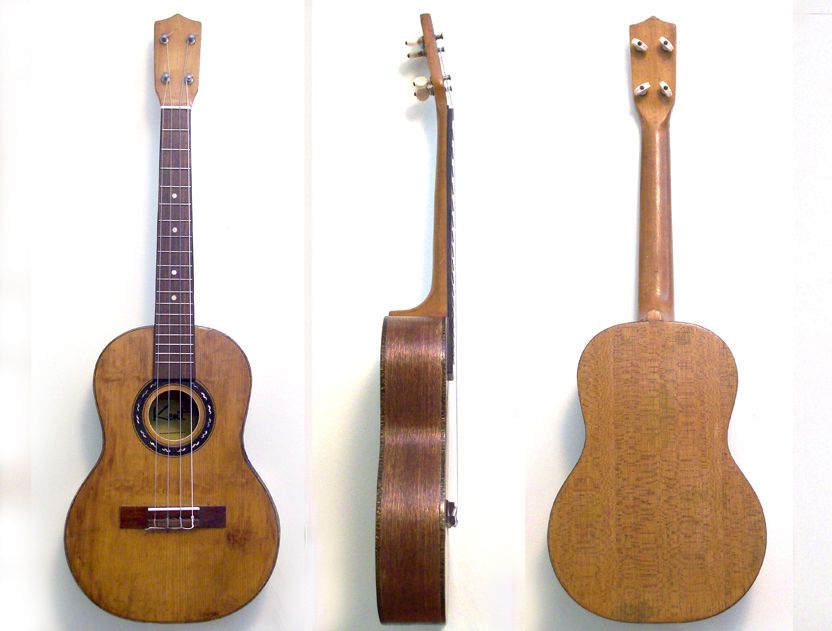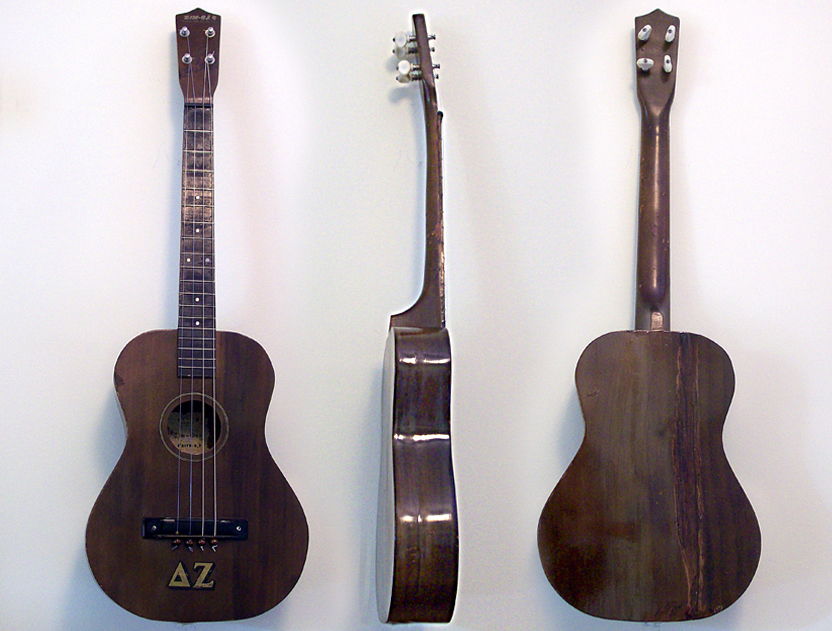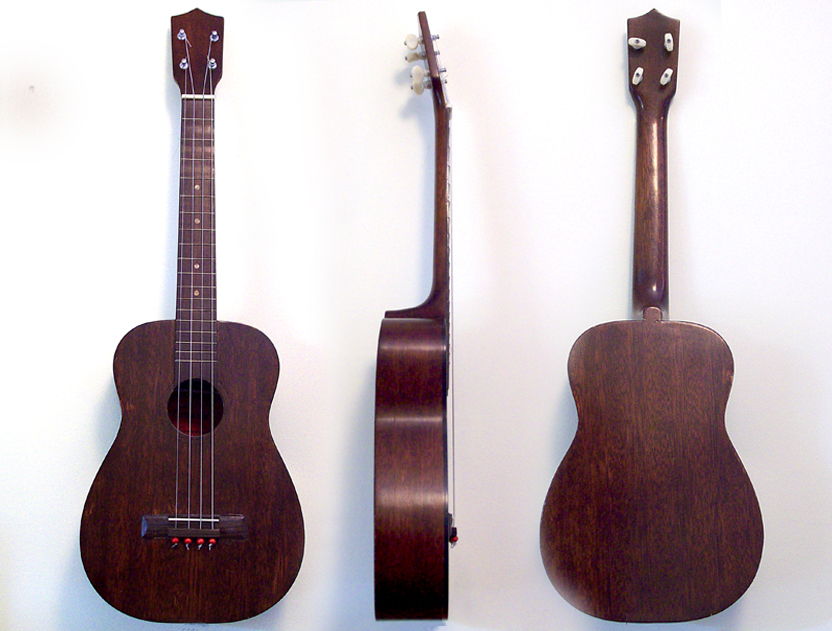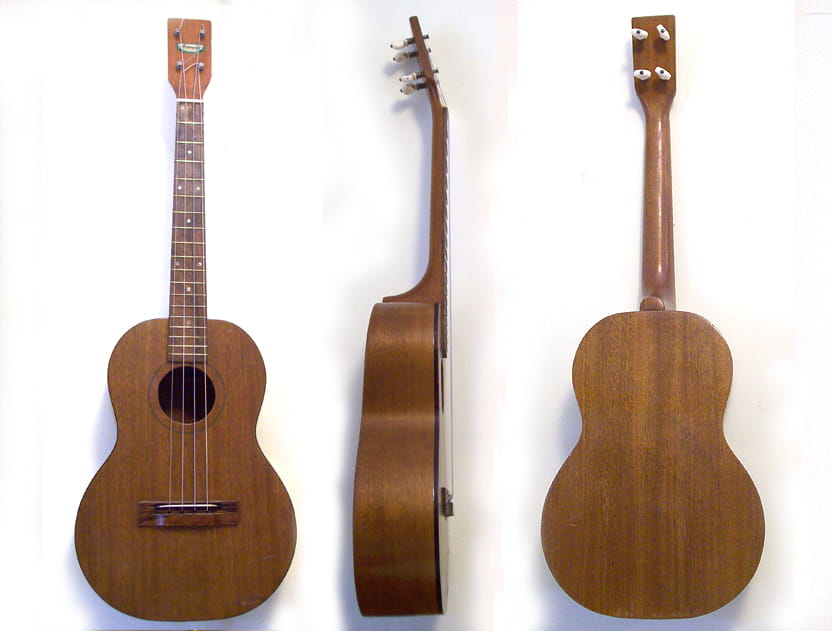

A bit of history:
Barnett Samuel & Sons started making Banjos in London in the late nineteenth century and the range came to include Banjoleles. In 1928 Barnett Samuel was renamed The Decca Gramophone Co. Ltd, (as they had previously founded Decca as a portable gramophone arm and this was now the biggest part of the business) as part of a lot of corporate manuvering.
The main brand for Barnett Samuel Banjos (and post takeover Rose Morris Banjos), was John Grey & Sons. The name itself is a probably fiction as there is no records of a John Grey ever being involved, never mind his son. The John Grey & Son name was sometimes used in conjunction with Dulcetta also before the take over and there have been instruments just branded Dulcetta.
To really confuse the issue, Barnett Samuel also produced a large range of instrument they branded Dulcet or sometimes B.S. Dulcet and this range included Banjos and Banjoleles. This may have been a result of Barnett Samuel using different factories to make different ranges. However, Dulcets are not Dulcettas nor are they John Grey & Son and use of the Dulcet name does not appear to have survived the 1928 takeover.
So that makes this instrument around 90 years old.
I got this example from my son who brought it for £10 (approx. $13). It needed the skin tightening, the neck reset and a new truss rod for the body. No doubt originally it would have been a wooden item but I made this one up from lamp parts from a scrap pile and the local hardware store. The paint finish appears to be original.
Because the friction tuners are quite old, there is not a lot of grip and the screw needs to be very tight. I have replaced them with a set of Grover Sta-tite which closely match the originals.
The first set of strings were Worth but I do not like them much as they are very thin and a tad bright. Generally I am not a fan of fluorcarbon strings. Must be my chunky preferment.
The replacement D’Addario are much better in both sound and feel.
Maker: Regal
Model: Standard
Top: Solid Spruce
Back and Sides: Solid Birch
Fretboard and Bridge: Wood
Saddle and Nut: Wood
This is an interesting little ukulele. All the clues point to Regal of Chicago as the maker. The bridge is typical and there is another example on the internet with the same decal decoration. It also has a “Standard Ukulele” label inside (see Jottings for more on this).
The Standard approved label places it between 1927 and around 1937. It is fancy for a low end Regal.
There must have been an over enthusiastic strum at some time to have removed a piece of the top from the edge of the sound hole. It has been patched and it is beyond my skills to try to merge it in any more. I believe these knocks and scrapes are all part of the item history, so I have left it alone.
The original tuners have been replaced. Over the years the headstock wood has compressed beyond the adjustment range of the tightening screw. So it was not possible to get enough friction to tune.
As the Standard label appeared in 1927 and in the case of Harmony lasted for around 10 years I think we can guess at around 85 odd years for the age of this ukulele.
Maker:Buckeye
Model:
Top: Laminated Birch
Back and Sides: Laminate Birch
Fret board and Bridge: Wood.
Saddle and Nut: Wood
Grossman Music Co. (or Corp.) is a musical instrument distributor based in Cleveland Ohio . Like most distributors they never actually made the Ukuleles or Banjoleles under their own name but they did register and brand a lot of the instruments they distributed. Brands like Buckeye, Red Dragon and Little Pal.
Maker: Kay
Model:
Top: Solid Birch
Back and Sides: Solid Birch.
Fret board and Bridge: Plastic and wood
Saddle and Nut: Plastic and wood
Incorporated in 1921 as Stromberg-Voisinet, this company's history goes back to 1890, when it was established as the Groeschel Mandolin Company. It was one of several musical instrument manufacturers in Chicago during the early part of the twentieth century producing instrument under its own name and OEM instruments for others to brand,I
Henry "Kay" Kuhrmeyer brought the company in 1928, hired three former Lyon & Healy lutheirs and in 1931 The Kay Musical Instrument Company was formed. Kay primarily manufactured "department store" style, inexpensive Guitars, Banjos and Ukuleles, like Penncrest for J C Penny, or Concertone for Montgomery Ward, but also specialized in high end Archtop Guitars
Kay also brought out the KeyKord, an early Baritone/Tenor Guitar around the time the company changed its name.
By the mid fifties, the Kay line was centred on electric instruments. In the 1960's Kay Musical Instruments moved out of Chicago, and in 1965 Kay was sold to Seeburg, a company specializing in juke boxes. Valco bought Kay from Seeburg in 1967, and during Valco's ownership, Kay's catalogue was simply reprinted with Valco's name at the head,
Kay was pretty much a budget brand. However, It is solidly built. It is light and has a good tone. The plastic fretboard with a zero fret makes for good intonation
Maker: B&M
Model: Champion
Top: Solid Mahogany
Back and Sides: Solid Mahogany
Fret board and Bridge: Wood.
Saddle and Nut: Wood and Plastic
B&M stands for Barnes and Mullins
Founded in the 1894 by Samuel Bowley Barnes and Albert Edward Mullins. In the 60's they were distributing Japanese imported Ukuleles branded Champion and Banjoleles branded B&M.
Maker: Harmony
Model:
Top: Solid mahogany
Back and Sides: Solid mahogany
Fret board and Bridge: Wood.
Saddle and Nut: Wood.
It is said you cannot be a true petrolhead unless you have owned an Alfa Romeo. (Italian, gorgeous but unreliable). So it is with ukuleles, you need to have played or own a Harmony ukulele.
They are plentiful and represent good value. Often made from solid mahogany with wood or plastic fretboards. See Jottings for more on the Plastic fretboards.
Dated approximately from the headstock label this one is from the mid to late 1950s. Slightly upmarket as it has the timber fretboard instead of the plastic one, echos of the Roy Smeck models.
Maker: Harmony
Model: 1251/2
Top: Solid Birch
Back and Sides: Solid Birch
Fret board and Bridge: Plastic and wood
Saddle and Nut: Wood.
A rather jolly ukulele. It cost $8.50 in 1959.
Maker: P'Mico
Model: Collegiate
Top: Solid Birch
Back and Sides: Solid Birch
Fret board and Bridge: Wood
Saddle and Nut: Wood
P'Mico Collegiate Model Soprano Ukuleles were made by Harmony.
"P'mico" was a brand name of Progressive Musical Instrument Company. The name P'IMCO was registered in 1923. A wide range of interesting and often colorful ukes were sold bearing this brand in the 1920's and early 30's. The headstock carries a decal depicting a ribbon and banner with the legend "Collegiate, product of P'Mico New York".
This one has an interesting image on the back. The letters HFR in a diamond shape. I have seen this on another ukulele so it must mean something?
Maker: Conrad
Model: 1594
Top: Solid Mahogany
Back and Sides: Laminate Mahogany
Fret board and Bridge: Plastic and wood
Saddle and Nut: Wood and plastic
Made in Japan by Matsumoku. They started out in the early 1900's as a maker of Japanese cabinets. In 1951 they were taken over by Singer Sewing Machine Co. but in the 60’s Singer moved the cabinet making to the Philippines so they had to find new products. They did OEM work for lots of people including some of the other Japanese OEM firms who could do the budget work but subcontracted the top quality ,
Conrad distributed in the US by
David Wexler and co
Chicago
I also have the ducky little fabric/plastic gig bag for this in chequered greens.
Maker: Capital
Model:
Top: Laminated Birch
Back and Sides: Laminate Birch
Fret board and Bridge: Wood
Saddle and Nut: Wood
This is an example of the typical sopranos made in Japan and imported under a brand name. In this case Capitol. This name dates from the 60s and 70s. It needed a bit of tidying up around the neck/body joint. The friction tuners look to be original but have Phillips screwheads. I think this might put the date in the 70s rather than the 60s.
Yet another Harmony soprano. This time it is a solid mahogany one with the plastic fretboard.
The difference is that it was endorsed by Roy Smeck. He was a very famous ukulele virtuoso of the 50s and 60s.
The wood used was very thin and as a result cracked easily. This one has had a few repairs over the years.
Maker: Regal
Model: Standard
Top: Solid mahogany
Back and Sides: Solid mahogany
Fretboard and Bridge: Wood
Saddle and Nut: Wood
This ukulele was bought in several pieces. The neck was detached and there were holes in the upper bout on both sides of the neck. There was also a small bag holding most of the missing body parts.
After some careful restoration and missing wood part fabrication the body was repaired and the neck replaced.
There is a "Standard Approved' label inside which dates it to between 1927 and mid 1930's.
No maker's label but the Standard Approved label was popular with the Harmony company and so given the fancy bindings it is probably a REGAL.
Maker: DECCA
Model: 432
Top: Solid mahogany
Back and Sides: Solid mahogany
Fretboard : Plastic
Saddle and Nut: Wood and Plastic
Made in Japan by Teisco for the British Decca record company and distributed by "Decca distributing Company" of New York, New York.
It has the plastic pre formed fretboard.
Nice "nothing special" example.
Maker: Unknown
Model: Unknown
Top: Solid mahogany
Back and Sides: Solid mahogany
Fretboard and Bridge: Wood
Saddle and Nut: Wood
Another orphan from the storm in need of TCL. The back was missing a piece and the front had large full length cracks. The kerfing inside was loose and there was no bridge or tuners.
I took the front and back off. Repaired and reinforced the front cracks. A new piece was glued to the back. After re-gluing the kerfing both front and back were re-glued in place.
A new bridge was made from a new block and a wood saddle used instead of the usual plastic one. The tuner holes showed no sight of fixing screws and so wooden tuners were assumed. I made these by modifying some violin pegs.
These wooden tuners indicated either very early or war time when metal was scarce. I am going with very early.
There is a maker's ink stamp inside which tantilizingly reads
A
HAWAIIAN
UKELELE
Made by
? ? Co
I cannot make out the maker's initials.
Maker: Harmony
Model: Unknown
Top: Solid mahogany
Back and Sides: Solid mahogany
Fretboard and Bridge: Wood
Saddle and Nut: Wood
Another rather nice soprano made from solid mahogany.
Maker: Globe
Model: Unknown
Top: Solid birch?
Back and sides: Solid birch?
Fretboard and Bridge: Wood
The Globe Musical Instrument Manufacturing Co. moved to St Charles Illinois, a suburb of Chicago in 1915, By 1926 they were producing 250,000 instruments a year and it was still going strong in 1937. In its day, it ranked with the other big Chicago makers like Harmony or Kay. The most famous brand it made was La Pacific, a range that included Ukuleles and Banjoleles.
This example had a few small cracks and a somewhat distressed finish. It was also missing the 12th fret at the neck/body joint. The neck was reset and a new fret made from some flat brass strip.
The other problem was the bridge position. As located, it was not right for the usual nut-12th fret-saddle ratios. When the bridge was removed, the finish do not show any sign of the bridge being located elsewhere The decision was taken to relocate the bridge to the “proper” position. This meant some finish fettling to cover the original bridge location.
Maker: Japan
Model: Unknown
Top: Solid Spruce
Back and Sides: Solid mahogany
Fretboard and Bridge: Wood
Saddle and Nut: Wood
This was gifted to me and so I know a little about it's history. It was a Christmas gift in 1951. So that makes it around late 40 to early 50s.
The tuning pegs appear to be original as the holes in the headstock are tapered.
Aloha was used a lot during this period for it's Hawaii contection. The better quailty instruments were made in Japan. the distrbutor was Kunz Taylor & Co Los Angeles.
Maker: Matador
Model: unknown
Top: Laminated mahogany
Back and sides: Laminate mahogany
Fretboard and Bridge: Mahogany
This was brought in a distressed condition. The body had multiple cracks and splits. The fretboard was wavy and the strings buzzed everywhere.
The body repairs were straightforward but the fretboard required a re-surface and complete re fret. The bridge was converted to through the top. A new set of Grover friction tuners finished off the rescue.
Matador ukuleles are not common. Their guitars are better known. I had a Matador 12 string at one time and the headstock badge was the same. The guitar was made in Japan so it is likely this ukulele was made there as well.
I can find no mention of Matador making ukuleles. Matador guitars where made in Japan by the Teicso Corp. The Matador logo is the same as the one on the 12 string matador I used to own.
This ukulel was in poor shape. There are unglued and badly glued top and bottom joints. The fretboard is wavey. It needed the frets removed leveled and re fretted.
Maker: Artist
Model: 3525
Top: Solid Mahogany
Back and Sides: Solid Mahogany
Fret board and Bridge:Wood
Saddle and Nut: Plastic
Made by Tokai. They were founded in 1947 and were very much part of the occupied Japan boom and produced instruments branded Artist, Conrad Drifter, Fernandes, Hondo, Love Rock, Mosrite, Sigma and Silver Star, They may have produced Gaban, Gallan, Gession, Hummingbird and Robin.
Maker: Crossroads
Model: SU 041T
Top: Laminate Mahogany.
Back and Sides: Laminate Mahogany
Fret board and Bridge: Rosewood.
Saddle and Nut: Plastic.
Cannot find much about these Crossroad models and they are still sold today.
Maker: Kent
Model:
Top: Solid Spruce.
Back and Sides:Laminate Mahogany
Fret board and Bridge: Wood.
Saddle and Nut: Plastic
Made by Guyatone. Originally founded in the 1930's by Mitsuo Matsuki and Atsuo Kaneko, (who later helped found Teisco), making Guitars branded Guya for the Japanese market. The were also heavily involved in the Japanese OEM production of the 60's and 70's, producing a lot of different brands. When they were doing the OEM work they produced instruments branded Antoria, Barclay, Broadway, Coronado, Crestwood, Delta, Futurama, Guyatone, Howard, Hi-Lo, Ibanez, Ideal, Imperial, Johnny Guitar, Kent, Kingston, Lafayette, Lake, Montclair, Omega, Orpheus, Prestige, Royalist, Saturn, Silhouette, Silvertone, Vernon, Winston, Zenta and probably produced Beeton, Bradford, Canora, Maxwell and Regent.
This example is in a distressed condition. There are body cracks, failed joints and missing inlay binding. These were addressed. I choose not to fully restore the appearance but leave the marks of a life well lived.
ZIM GAR
Maker: Zim Gar
Model:
Top: Laminate Mahogany
Back and Sides: Laminate Mahogany
Fret board and Bridge: Wood
Saddle and Nut: Plastic
Gar-Zim Musical Instrument Corporation
They were importers from Japan and distributed from Brooklyn, NY.
Maker: Crestwood
Model:
Top: Solid Mahogany
Back and Sides: Solid Mahogany
Fret board and Bridge: Rosewood.
Saddle and Nut: Plastic
Another by Guyatone. Originally founded in the 1930's by Mitsuo Matsuki and Atsuo Kaneko making Guitars branded Guya for the Japanese market. Production stopped for WWII and after the war Matsuki started up again founding first the Tokyo Sound Co. and in 1956 founded Guyatone. They were the first Japanese manufacturer to sell their own brand named instruments to the American public. They were heavily involved in the Japanese OEM production of the 60's and 70's. When they were doing the OEM work they produced instruments branded Antoria, Barclay, Broadway, Coronado, Crestwood, Delta, Futurama, Guyatone, Howard, Hi-Lo, Ibanez, Ideal, Imperial, Johnny Guitar, Kent, Kingston, Lafayette, Lake, Montclair, Omega, Orpheus, Prestige, Royalist, Saturn, Silhouette, Silvertone, Vernon, Winston, Zenta and probably produced Beeton, Bradford, Canora, Maxwell and Regent.
Maker:Conrad
Model: 73125
Top: Solid Mahogany
Back and Sides: Solid Mahogany.
Fret board and Bridge: Rosewood.
Saddle and Nut: Plastic
For information on Conrad see entry in the Vintage Soprano entry.
Maker:Harmony
Model:
Top: Solid Mahogany
Back and Sides: Solid Mahogany.
Fret board and Bridge: Rosewood.
Saddle and Nut: Bone
This particular model is the amongst the most desirable of the 1950-60s Harmony Ukuleles. All solid mahogany and lightly built.
The headstock label indicates a 1950s date. Apparently in the 50s these had bone saddles (glued in) and bone nuts. Then in the 60s they changed to plastic. The bodies are solid mahogany and the fretboard and bridge rosewood.
This one has a glued in bone saddle.
It is well known that these Harmony baritones had a high action out of the factory. There is no sigh of neck movement so a reduction in the saddle height is needed. The easiest way is through the body. The saddle itself is less than 1/8” high. This means a reduction in the wood part and a deepening of the saddle slot to allow this saddle to be lowered to reduce the action.
The through the top option is quite common in these circumstances and it returns the ukulele to a playable condition.
These were serious instruments. At a time when you could buy a sporano for $3-5 these were listed at almost $40.00.
If you want to find out more about all these older makes and ukuleles you should visit the excellent Lardy's Ukulele Database
